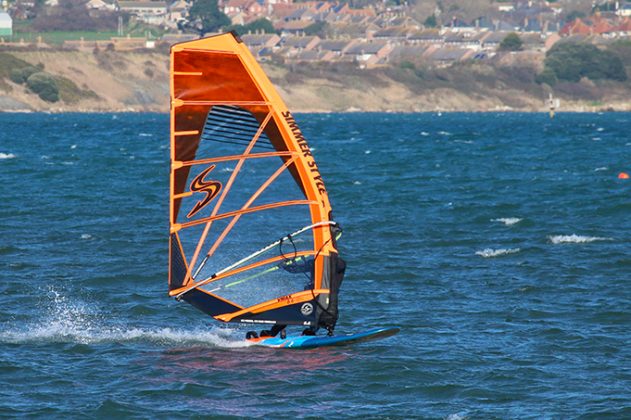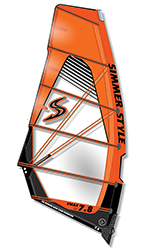
SIMMER V-MAX 6.6M TEST REVIEW
SIMMER V-MAX 6.6M TEST REVIEW
OVERVIEW
The V-Max is Simmer’s solution to the no-cam freerace conundrum and is available in seven sizes from 4.8m to 8.6m, each size possessing six battens. Whilst originally recommended for use on Simmer’s SDM masts in their literature, it was supplied for test on one of Simmer’s RDM10 masts, setting with a significant amount of looseness in the head panels, yet remaining relatively tight in the mid-leech. Fully downhauled, the V-Max has a moderate to high amount of luff curve, and whilst only the batten just above the boom cutout retains any connection with the mast, there’s plenty of shape pushed low and forward in the sail’s profile. When other brands are moving towards higher aspects ratios in their no-cam freerace sails, Simmer are going the other way, the V-Max displaying the shortest luff length here, giving it a distinctly compact appearance. Detailing is certainly up to date, with x-ply used in the higher integrated batten pockets to ensure minimal stretch and maximum weight saving. There are two very visible Kevlar stretch control tendons fanning out from the clew eyelet and even the head panel has been considered, opting for use of Dacron to aid rolling once de-rigged. It certainly looks the part, but would the RDM supplied be up to the task or would the V-Max demand the use of an SDM?
BRAND CLAIM
“V-Max offers quick and simple rigging, great low-end power, and locked in stability. V-Max is the best choice for the sailor who wants a camber free, light-weight lightspeed sail.”
PERFORMANCE
It has been a few years since we have tried the V-Max from Simmer, and we have to say it impressed us a lot. The centre of effort is low and forward as before, and yet there’s more crispness and precision to the feedback than we remember. At idle it feels balanced and comfortable in the hands, the thin Dacron luff panel allowing the sail to breath and stretch as the first gust hits, particularly in the lower panel, where the belly of the sail swells significantly. Once this luff panel (and any stretch in the luff sleeve), has reached its elastic limit, the direct response of the second x-ply luff panel takes over, giving the V-Max its endearing active character. It flourishes in powered conditions, quickening in every additional gust and pinning the board down, so that the rider can concentrate on picking their course to get ahead of their peers. And all this on the RDM mast provided! There certainly isn’t any cause for concern in using it on an RDM, but to check we also sheathed the V-Max onto a constant curve SDM we had in stock. To this end, it does feel more direct on the thicker diameter mast, but for most people interested in this sail, the performance on an RDM is more than ample. In fact, the little extra softness provided by the additional give in the luff sleeve would be a welcome asset. In overpowered conditions, the V-Max remains manageable and dependable. The looseness in the upper panels can be felt, and yet there’s not a hint of the mid-leech hooking or any control issues. In transition the V-Max’s compact nature comes into play, feeling positive in the hands at entry and encouraging the rider to maintain a low controlled stance. The low power and progressive delivery then makes it obedient and ‘tameable’ even in severe conditions.
THE VERDICT
A pleasure to use whatever the conditions or board style it is partnered with, the V-Max is both manageable and rewarding to use, with a capacity to surprise when the conditions turn on.
Other sails in this test:
TEST OVERVIEW PAGE

